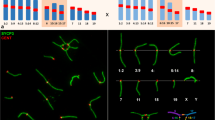Abstract
The meiotic behaviour of chromosomes 1R, 2R and 5R was studied in C-banded preparations of autotetraploid rye. Analysis of pairing and chiasma formation was based on metaphase I configurations, using the model designed by Sybenga, with slight modifications. Frequencies of two modes of pairing (one quadrivalent or two bivalents) differed from those expected for random pairing. Although preferential pairing for some arm pairs of chromosome 2R was detected, this did not seem to be the cause of the increased bivalent pairing. This increase was attributed to either the spatial separation of the four homologous chromosomes in some premeiotic cells into two groups of two, or a correction of the synaptonemal complex, or both. The number of chiasmate associations showed variation between chromosomes and between arms within the same chromosome. It was closely related to arm length, but different after quadrivalent and bivalent pairing. This is suggested to be a consequence of partner exchange interfering with pairing and, consequently, with chiasma formation, and a different chiasma distribution after quadrivalent pairing. Variation between chromosomes in the frequencies of alternate and adjacent co-orientation in metaphase I quadrivalents without interstitial chiasmata suggests that the relative positions of the centromeres in the quadrivalent influence their co-orientation.
Similar content being viewed by others
References
Arana P, Santos JL, Giráldez R (1980) Chiasma interference and centromere co-orientation in a spontaneous translocation heterozygote of Eucorthippus pulvinatus gallicus (Acrididae; Orthoptera). Chromosoma 78:327–340
Arana P, Santos JL, Henriques-Gil N, Giráldez R (1982) Centromere co-orientation in a spontaneous translocation heterozygote of Euchorthippus pulvinatus gallicus (Acrididae, Orthoptera). Genetica 58:81–84
Avivi L (1976a) The effect of genes controlling different degrees of homoeologous pairing on quadrivalent frequency in induced autotetraploid lines of Triticum longissimum. Can J Genet Cytol 18:357–364
Avivi L (1976b) Colchicine-induced bivalent pairing of tetraploid microsporocytes in Triticum longissimum and T. speltoides. Can J Genet Cytol 18:731–738
Doyle GG (1963) Preferential pairing in structural heterozygotes of Zea mays. Genetics 48:1011–1027
Doyle GG (1969) Preferential pairing in trisomies of Zea mays. Chromosomes Today 2:12–20
Elci S, Sybenga J (1976) Incomplete preferential pairing in a tetraploid Secale hybrid carrying translocations: multivalent configuration frequencies and marker segregation. Genetica 46:177–182
Gilráldez R, Orellana J (1979) Metaphase I bonds, crossing-over frequency and genetic length of specific chromosome arms of rye. Chromosoma 72:377–385
Giráldez R, Santos JL (1981) Cytological evidence for preferences of identical over homologous but not-identical meiotic pairing. Chromosome 82:447–451
Giráldez R, Cermeño MC, Orellana J (1979) Comparison of C-banding pattern in the chromosomes of inbred lines and open pollinated varieties of rye. Z Pflanzenz 83:40–48
Hobolth P (1981) Chromosome pairing in allohexaploid wheat var. Chinese Spring. Transformation of multivalents into bivalents, a mechanism for exclusive bivalent formation. Carlsberg Res Commun 46:129–173
Jackson RC, Casey J (1980) Cytogenetics of polyploids. In: Lewis WH (ed) Polyploidy. Biological relevance. Plenum Press, New York London, pp 17–44
John B, Henderson SA (1962) Asynapsis and polyploidy in Schistocerca paranensis. Chromosoma 13:111–147
Naranjo T, Lacadena JR (1979) Analysis of centromere co-orientation in a rye-wheat derivative by means of C-banding. Chromosoma 73:227–235
Orellana J, Giráldez, R (1981) Metaphase I bound arms and crossing-over frequency in rye. I. Open pollinated varieties. Chromosoma 84:439–449
Rasmussen SW (1977) Chromosome pairing in triploid females of Bombyx mori analyzed by three-dimensional reconstructions of synaptonemal complexes. Carlsberg Res Commun 42:163–197
Rasmussen SW, Holm PB (1979) Chromosome pairing in autotetraploid Bombyx females. Mechanism for exclusive bivalent formation. Carlsberg Res Commun 44:101–125
Rasmussen SW, Holm PB (1980) Mechanics of meiosis. Hereditas 93:187–216
Rhoades MM (1952) Preferential segregation in maize. In: Cowen JW (ed) Heterosis. Iowa State College Press, Ames, pp 66–80
Santos JL, Orellana J, Giráldez R (1983) Pairing competition between identical and homologous chromosomes in rye and grasshoppers. Genetics 104:677–684
Snope AJ (1967) Meiotic behaviour in autotetraploid maize with abnormal chromosome 10. J Heredity 58:173–177
Sybenga J (1968) Orientation of interchange multiples in Secale cereale. Heredity 23:73–79
Sybenga J (1975a) Meiotic configurations. Monographs on theoretical and applied genetics, vol. 1. Springer, Berlin Heidelberg New York
Sybenga J (1975b) The quantitative analysis of chromosome pairing and chiasma formation based on the relative frequencies of metaphase I configurations. VII. Autotetraploids. Chromosoma 50:211–222
Sybenga J (1983) Rye chromosome nomenclature and homoeology relationships. Workshop report. Z Pflanzenz 90:297–304
Timmis JN, Rees H (1971) A pairing restriction at pachytene upon multivalent formation in autotetraploids. Heredity 26:269–275
Vosselman L (1981) Meiotic segregation of five different reciprocal translocations in the onion fly Hylemya antiqua (Meigen). Chromosoma 81:727–738
Author information
Authors and Affiliations
Rights and permissions
About this article
Cite this article
Naranjo, T., Orellana, J. Meiotic behaviour of chromosomes 1R, 2R and 5R in autotetraploid rye. Chromosoma 89, 143–150 (1984). https://doi.org/10.1007/BF00292898
Received:
Revised:
Issue Date:
DOI: https://doi.org/10.1007/BF00292898




